In Japanese, OL means a woman who works an office job, it's an abbreviation of "office lady," and includes anything from pencil-pushers, to managers, CEOs, etc. It's not a specific profession. OL is the female counterpart of salaryman.
Sometimes, OL is translated to English as "secretary" due to stereotypes about working women.
OL is pronounced oo-eru オーエル.
See: katakanized alphabet letters.
Anime: Kobayashi-san Chi no Maidragon, 小林さんちのメイドラゴン (Episode 8, Stitch)
Meaning
OL is an abbreviation of:
- ofisu redhii
オフィスレディー
Office lady.
It's the female counterpart to:
- sarariiman
サラリーマン
Salaryman.
These terms are used toward people who work office jobs, desk jobs, clerical jobs, administrative jobs, etc. climbing corporate ladders, and so on.
When the person is a man, it's called a salaryman, and when it's a woman, it's called an OL.
Left salaryman: Nifuji Hirotaka 二藤宏高
Right OL: Momose Narumi 桃瀬成海
Rightmost OL: Koyanagi Hanako 小柳花子
Anime: Wotaku ni Koi wa Muzukashii ヲタクに恋は難しい (Episode 1)
Like salaryman, OL is a wasei-eigo 和製英語, a Japanese-made English word, that is, what "office lady" means in Japanese differs from how it's used in English-speaking countries like America.
Also like salaryman, OL is not an exact profession, but a general term and lacks a precise definition.
- The staff card of Suzukaze Aoba 涼風青葉, who is an OL, has her job labelled as gurafikkaa グラフィッカー, which is an artist that creates graphical assets for games.
- If OL was an actual job, the staff card would read "office lady" instead.
Furthermore, it's not even exact that OL is exactly a salaryman but female.
For example, the term salaryman is sometimes restricted only to men working in private enterprises. A civil servant in an administrative job, despite wearing a suit and looking exactly like a salaryman, wouldn't count. By extension, if this person were a woman, they wouldn't be an OL either.
Middle: Yamagami Lucy Kimiko Akie Airi Shiori Rin'ne Yoshiho Chihoko Ayano Fumika Chitose Sanae Mikiko Ichika Yukino Reina Eri Ai Tamiko Chikage Emilia Julia Shizue Erina Chisa Yumeka Natsuki Ranran Rieko Setsuri Chikako Azumi... (rest abbreviated)
山神ルーシー貴美子明江愛里史織倫弥由保知帆子彩乃冨美佳千歳早苗美紀子壱花由紀乃麗奈恵利亜衣多美子千景エミリア樹理亜志津江絵里那千紗夢佳夏希蘭々理恵子刹里智香子あずみ・・・(以下略)
Right: Hasebe Yutaka 長谷部豊
Anime: Servant x Service, サーバント×サービス (Episode 1)
- Context: the characters above are chihou-koumuin 地方公務員, "regional civil employees," therefore, the guy at the right isn't a salaryman, and the woman bowing isn't an OL.
Like salaryman, the definition is shaky. Civil employees receive salaries, and the female ones are literally ladies in offices, so it's very possible for people to just use the term OL toward any female office worker.
"Secretary" Translation
Sometimes, OL is translated to "secretary" in English. This translation is incorrect, but just because it's incorrect, that doesn't mean it can't be right.
Let's start with the correct.
A "secretary" is:
One employed to handle correspondence and manage routine and detail work for a superior.[secretary - merriam-webster.com, accessed in 2020-02-21]
In Japanese, that would be:
- hisho
秘書
Secretary.
A hisho can be an OL, and an OL can be a hisho, but these two terms don't always overlap.
First off, an OL can work any office job, not only as a secretary.
Second off, a secretary is a gender-neutral occupation. There are male secretaries as well as female secretaries. A female secretary is an OL, but a male secretary is not.
Stereotypically, in various languages, the image of jobs like "secretary" and "nurse" is a woman, not a man.
Presumably, this comes from the sexist stereotype that women are the inferior sex and can't do jobs as well as men. You can't have a female doctor, women can only be the lesser nurse, who assists a male doctor. No female boss, women can only become the secretary, who assists the boss.
The hot secretary only has her job because she's sexy, and certainly not because of her apt secretarial abilities. She does sexual favors for her boss in exchange for promotions and bonuses. Her male coworkers leer at her while commenting on her physical attributes.
Such are the stereotypes surrounding the term "secretary" in English.
However, none of this stuff has anything to do with the job of a secretary specifically. You could apply it to any office job, and it would make sense, so we're really talking about stereotypes toward office ladies in general here, except that in English we don't say "office lady," we say "secretary."
Because the term "secretary" in English is loaded with the same connotations that OL would have in Japanese, sometimes it's best to translate OL as "secretary," even though it doesn't literally mean "secretary."
The correct thing to do would be to refrain from this translation as it reinforces sexist stereotypes, but if you wanted to get the meaning across to a western audience this would be the right choice.
Anime: Tensei shitara Slime Datta Ken, 転生したらスライムだった件 (Episode 11, Stitch)
- Third off: what if a character is a female secretary, but there's no office?
Origin
Before OL, BG was another term that was used to refer to office women.
- bii-jii
BG
bijinesu gaaru
ビジネスガール
Business girl.
The term BG began its spread in 1949, through the women's magazine Sutairu スタイル, "Style." However, as Tokyo prepared for the Olympics, NHK, a TV and radio broadcaster, decided to ban the term from airing in 1963 for its association with prostitution(ytv.co.jp/michiura).
Specifically, it seems in America BG, or B-girl, abbreviates "bar girl," which would refer to hostesses, strippers, etc., so, presumably, it was banned to avoid having Americans coming to the Tokyo Olympics and hearing about all these bar girls on TV, or something weird like that.
This doesn't make a lot of sense, but okay.
The ban led another women's magazine, Josei Jishin 女性自身, "Female Self," to poll its readers for a replacement for BG(ytv.co.jp/michiura).
The top 10 results of the poll were(女性自身, as cited in OL - ja.wikipedia.org):
- Ofisu Redhii
オフィス・レディー
Office Lady. (4256 votes.) - Ofisu Gaaru
オフィス・ガール
Office Girl. (4189 votes.) - Sararii Gaaru
サラリー・ガール
Salary Girl. (2964 votes.) - Kyaria Gaaru
キャリア・ガール
Career Girl. (2894 votes.) - Bijinesu Redhi
ビジネス・レディー
Business Lady. (2302 votes.) - Ofisu Uuman
オフィス・ウーマン
Office Woman. (2016 votes.) - Bijinesu Uuman
ビジネス・ウーマン
Business Woman. (1882 votes.) - biijii haishi hantai
BG廃止反対
Against abolishing "Business Girl." - Kyaria Uuman
キャリア・ウーマン
Career Woman. (1274 votes.) - Waaku Redhii
ワーク・レディー
Work Lady. (965 votes.)
There was a total of 26481 votes. The first place was "office lady," and that's how OL replaced BG as a term to refer to office women.
Note that third place was "salary girl," which was used at the time, but the winner was ultimately "office lady," which started being used instead.
- sore made no yobikata ni, "sarariiman" no taigigo de aru "sarariigaaru" mo atta ga, dounen, "atarashii jidai no hataraku josei" wo arawasu kotoba toshite, shuukanshi "Josei Jishin" no koubo de erabareta "ofisu redhi" ga toujou shi, shibaraku oo-eru no jidai ga tsuduku.
それまでの呼び方に、「サラリーマン」対義語である「サラリーガール」もあったが、同年、「新しい時代の働く女性」を表す言葉として、週刊誌『女性自身』の公募で選ばれた「ОL(オフィスレディ)」が登場し、しばらくはОLの時代が続く。(gomuhouchi.com, page 2)
Until then for how you'd call it, there was the opposite word of "salaryman," "salarygirl," however, at that same year, as a word for "the working women of a new era," the "office lady" chosen with the pool of the weekly magazine "Josei Jishin" made its appearance, and for a while the OL era continued.
According to the passage above, office lady wasn't that common of a term, or perhaps wasn't even an term, until it won first place in the poll.
Afterwards, it became normal for women to get promoted to managerial positions, so they started having whole careers in office, rather than just working at some low-level job in those offices, and the term "career woman" was also used(gomuhouchi.com, page 2).
Manga: Gokushufudou 極主夫道 (Chapter 5)
- yome wa dezainaa
嫁はデザイナー
[My] wife is a designer. - baribari no kyaria uumann
バリバリのキャリアウーマン
A genuine career woman.- baribari
バリバリ
Crunchy.
Working earnestly or decisively.
Genuine. Proper.
- baribari
There have also been more recent terms, like:
- kyarijo
キャリジョ
Career woman.
- jo 女 means woman.
I'm not really sure what's the difference between one and the other, honestly.
I mean, since they both mean basically the same thing at first glance, I guess people will just assume they mean the same thing, if it ever catches on.
Tropes
Since OLs are just salaryman-but-woman, there isn't much to say about them that wasn't already said in the article about salaryman. For the sake of reference, I'll list here some tropes that are exclusive to OLs.
See salaryman for office work tropes in general.
Office Romance
Generally speaking, OL characters are extremely rare in anime. Most anime takes place in high schools, not in offices, so the lack of office-working characters is to be expected.
One case that demands the existence of OL characters are series about romance in the workplace.
- sha-nai ren'ai
社内恋愛
Romance inside a company.- shanai ren'ai kinshi
社内恋愛禁止
Romance inside the company [is] forbidden. Isn't allowed.
Some companies have in place policies forbidding employees to have romantic relationships with other employees, to avoid the development of all sorts of non-profitable situations in the workplace.
- shanai ren'ai kinshi
- shokuba ren'ai
職場恋愛
Romance at workplace.
Right: Retsuko 烈子
Anime: Aggressive Retsuko, アグレッシブ烈子 (2016) (Episode 32)
- Context: a kemono salaryman uses a kabedon 壁ドン on an OL, causing her to visibly panic.
Typically, there's romance in the workplace only because the OL is single.
The logic is that, in a male dominated society, if a woman were married they'd stay in the house, being a housewife, depending financially on her husband. If she's working instead, then she mustn't be married.
Of course, this only makes sense if we completely ignore:
- tomo-bataraki
共働き
Both-working. Refers to a household in which both husband and wife earn money working.
Because in that case it wouldn't be a romance, it would be a drama.
- uwaki
浮気
Cheating.
Or worse:
- netorare
寝取られ
A genre of pornography featuring cheating.
Such OLs range from young women with dreams of financial success to slightly less young women who don't need no man and are seen as being too manly for being too independent, not able to get a boyfriend due to that until the story starts and they meet their future husband.
- kurisumasu keeki
クリスマスケーキ
Christmas cake. In Japan, cake is a food eaten on Christmas day, along with fried chicken. (I'm not joking.)
The term also refers to the idea that a woman is in her prime to marry before 25, and after that age she's like a Christmas cake leftover past 25th of December. (again, I'm not joking.)- Fun fact: Retsuko is exactly 25 years old.
I mean, pretty much all romance anime is young adult fiction, right? You don't see middle-aged OLs.
- The oldest character tagged as office lady on AniDB is the 30 years old Nishikino Mayumi 錦野麻弓 from the anime Bokura wa Minna Kawai-sou 僕らはみんな河合荘.[Tag: office lady - anidb.net, accessed 2021-02-25]
What happens to OLs after they turn 31 in anime? Do they disintegrate? Turn into a salaryman or into a wizard, or something like that? It's a mystery.
Some women who choose to be financially independent would rather prioritize their careers instead of chasing boyfriends, but, in anime, an OL that's single is typically bothered about being single, as a plot device or character trait, rather than uncaring about it.
Role Reversal
In some series, the OL is the breadwinner of the household, while her husband stays at home. This happens, for example, in Gokushufudou 極主夫道.
- fuufu
夫婦
Husband and wife. - sengyou shufu
専業主婦
Exclusive-job housewife.- A yojijukugo 四字熟語.
- sengyou means their job, gyou, is exclusively being a housewife, rather than doing anything else, i.e. they're a full-time housewife.
- sengyou shufu
専業主夫
Exclusive-job househusband.
- Same idea: a full-time househusband.
Sexual Harassment
Any series that takes place in a workplace with characters of both sexes has the potential of having sexual harassment as part of the plot or thrown around for some reason.
- seku-hara
セクハラ
- sekusharu harasumento
セクシャルハラスメント
Sexual harassment.
- sekusharu harasumento
- seku-hara de uttaete-yaru!
セクハラで訴えてやる!
[I] will sue [you] for sexual harassment!
Train Molester
Like the average Japanese salaryman, the average Japanese OL commutes to work by train, which means they fall victim of the cliché train "molester," chikan 置換, groping commuters around.
Right: random molester
Anime: Ojisan to Marshmallow, おじさんとマシュマロ (Episode 7)
Girls-Only After-Work Drinking Party
In the Japanese work culture, it's common for officer workers to go drinking to socialize with their colleagues after a day of work. This is a called a nomikai 飲み会, or "drinking meeting." An OLs-only nomikai is a joshikai 女子会, "girls meeting."
- Context: Wakabayashi 若林 is in love with Hige 日下, who is a guy.
- sake nomitee
酒飲みてぇ
[I] want to drink alcohol.- nomitee is a contraction of nomitai 飲みたい.
- tte wake de Wakabayashi kyou no yoru joshikai sunzo!
ってわけで若林今日の寄り女子会すんぞ!
[That's how it is, so] Wakabayashi, today's evening [we] will do a joshikai!- sunzo is a contraction of suru zo するぞ.
- Hige-san wa kuru-n-su ka?
ヒゲさんは来るんすか?
Will Hige-san come?- kuru-n-su ka is a contraction of kuru no desu ka 来るのですか.
- Wakabayashi contracts desu and masu to su, ssu. This is sometimes said to be a half-hearted type of keigo.
- joshikai da
女子会だ
It's a joshikai.- A "girls meeting" for drinking, and Hige is a guy.
- tte koto wa kuru-n-su ka?
ってことは来るんすか?
[Which means] [he] will come? - konee yo
来ねぇよ
[He] won't come!- konee is a contraction of konai 来ない.
- san-nin de yoyaku tottoku zo~
3人で予約とっとくぞー
[I] will make a reservation for three people~.- tottoku is a contraction of totte-oku とっておく.
- ussu
うっす
[Alright]. - izakaya
居酒屋
(a sort of Japanese bar-restaurant serving drinks, food, and snacks.) - hoppu steppu yokochou
ホップステップ横丁
Hop Step Alley. - doushita Wakabayashi! genki nai jan nome nome!
どうした若林!元気ないじゃん飲め飲め!
[What's wrong] Wakabayashi! [You're so quiet], drink drink!- genki 元気 is lively, energetic, so genki nai is the opposite: seeming down, being quiet, etc.
- nonderu ssu yo
飲んでるっすよ
[I] am drinking.
- Same as nonde-imasu yo 飲んでいますよ.
- okonna yoo
怒んなよー
Don't get angry~- Contraction of okoru na 起こるな.
- kondo mata Hige mo yobeba ii daroo
今度また日下も呼べばいいだろー
Next time [we just have to] call Hige, too, right?
- yobeba ii 呼べばいい means it would be "good," better, if we "call" Hige.
- See hou ga ii 方がいい.
Uniform Fetishism
You may have noticed through your life that secretaries seem to be target of some sort of fetishism, but is it because of what their job is about? Or is it just about what they wear?
A formal, business attire for women, which, again, has nothing to do with secretaries specifically, but with office ladies in general.
Naturally, there's no rule that says all OLs must wear the same outfit. OL is the job, not the clothes.
However, there exists an audience that likes OL characters for some reason, so when an artist draws a single OL character specifically for that audience, they end up having to draw the reasons, too.
See moe-zokusei 萌え属性 for details.
Mainly, OL outfits tend to feature things like:
- A white shirt or blouse. There's three common scenarios: it's easily see-through, if the top is unbuttoned there's cleavage, and if the OL has large breasts you end up with a cleavage window kinda effect between the buttons of the blouse.
- wai-shatsu
Yシャツ
White shirt. - sukebura
透けブラ
Bra seen-through.- sukeru
透ける
To be visible behind something else.
- sukeru
- wai-shatsu
- Black pantyhose, tights, just like bunny girls.
- kuro-taitsu
黒タイツ
Black tights.
- kuro-taitsu
- A black straight skirt. Never pleated skirts. Typically short, rather than the more modest pencil skirt, but without ZR, because the important thing are the tights.
- taito sukaato
タイトスカート
Tight skirt.
- taito sukaato
- A black jacket, optional.
- An employee tag, or sometimes a necktie, hanging between the breasts or pushed forward by them to emphasize volume.
- sutaffu kaado
スタッフカード
Staff card. - nekupai
ネクパイ
Neck-pai. (the term for this.)
- sutaffu kaado
In summary, it's black and white, like a document.
- Context: come on, this is just ridiculous. The shirt isn't even drenched in rainwater or anything. How come it's transparent? That makes no sense. Who would buy a shirt like this.
For reference, some examples:
Again, OL isn't about the clothes, it's about the job. You could have someone dressed up like the above but ending up being a teacher or a flight attendant, rather than an office lady.
Game: Helltaker
- Context: Helltaker is a free game about building your own harem of sharply dressed demon girls, some of which appear to be OLs for seemingly working office-related jobs, like customer service and chief executive officer.
Conversely, you could have an OL that's not recognized as an OL because they don't wear an OL-esque outfit. For example:
Right salaryman: Takiya Makoto 滝谷真
Anime: Kobayashi-san Chi no Maidragon, 小林さんちのメイドラゴン (Episode 1)
In the image above, we have two characters of different genders working the same job in the same office. If Makoto counts as a salaryman, then, logically, Kobayashi must count as an OL.
However, despite being a python programmer working for a private company, and definitely recognizable as a salaryman if she were a man, Kobayashi isn't actually recognizable as an OL at all as far as the audience is concerned.
To begin with, a lot of people who watched the anime didn't even recognize she was a woman in first place because she wore shirt, pants, and necktie.
But most importantly, a series such as this strategically creates characters to fit different niches for different niche audiences, so the author won't create a character that covers the same niche a different character already covered. That would be a waste.
This series introduced Elma afterwards as a more OL-like OL. If Kobayashi counted as an OL, there would be no need to have Elma as a second OL, so Elma was only made an OL because Kobayashi didn't look like an OL enough to count as an OL despite actually being one.
Thus we have two definitions for OL.
- The OL that's OL because she's a female salaryman.
- The OL that's OL because she looks like an OL.
In anime, looks tend to matter more. After all, if the OL can do any office-related job, and dress any way she wants, that's practically just a woman with a job. It's not very specific and note-worthy.
The protagonist of Shirobako is an OL, too, and she has almost zero in common with Kobayashi, dresses differently, her job is totally different, so what would be the point of grouping these two completely different characters in the same label? Wouldn't be very useful, would it?
Cute Ladies Doing Office Things
Normally, OL characters are rare, being either random background characters, or a single named character that only exists to fit a niche. However, sometimes you have a series that takes place in an office, and the entire cast is female, so everyone ends up being an OL.
Middle: Takimoto Hifumi 滝本ひふみ
Top right: Tooyama Rin 遠山りん
Right: Iijima Yun 飯島ゆん
Bottom right: Suzukaze Aoba 涼風青葉
Anime: New Game! (Episode 1)
- New Game! is a CGDCT that takes place in an office.
References
- OL - ja.wikipedia.org, accessed 2021-02-20.
- OLは死語か? - ytv.co.jp/michiura, accessed 2021-02-20.
- ビジネスガール、オフィスレディ、キャリアウーマン、キャリジョ。 - gomuhouchi.com, accessed 2021-02-24.
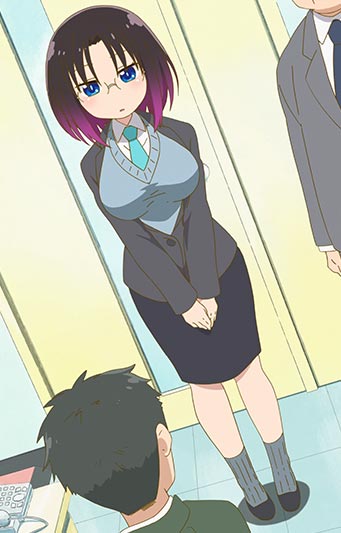

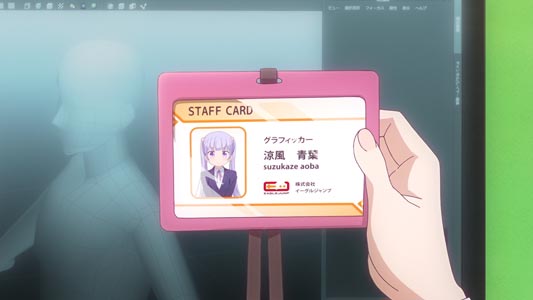


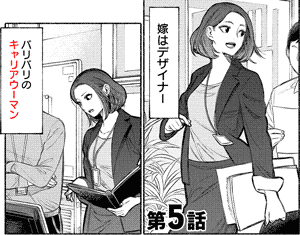

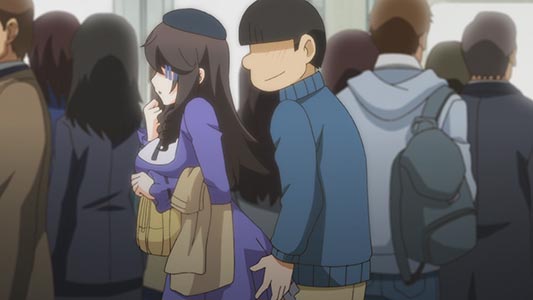
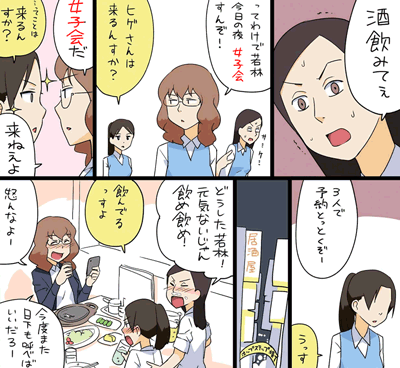

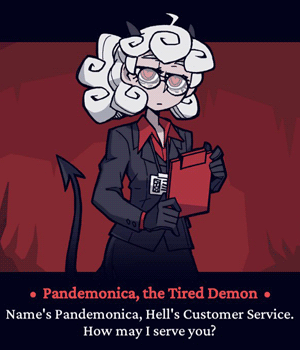

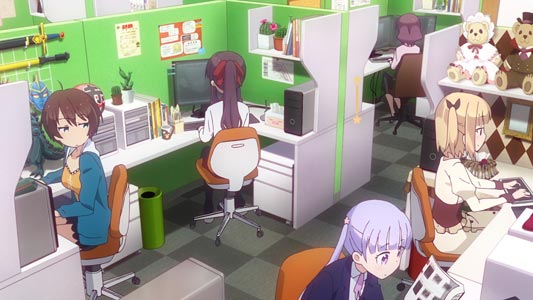
No comments: